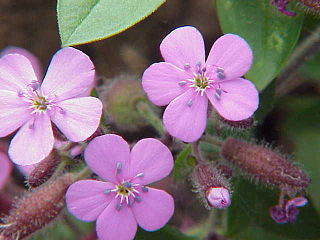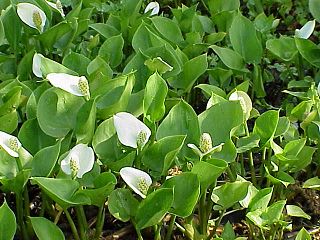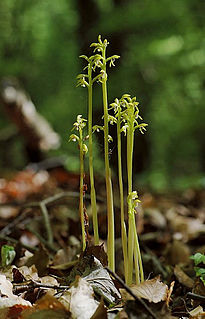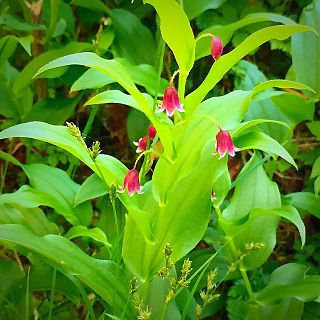
Saponaria is a genus of flowering plants in the family Caryophyllaceae, native to Asia and Europe, and are commonly known as soapworts. They are herbaceous perennials and annuals, some with woody bases. The flowers are abundant, five-petalled and usually in shades of pink or white. The genus is closely related to Lychnis and Silene, being distinguished from these by having only two styles in the flower. It is also related to Gypsophila, but its calyx is cylindrical rather than bell-shaped.

Tetrapanax papyrifer, the rice-paper plant, is an evergreen shrub in the family Araliaceae, the sole species in the genus Tetrapanax. The specific epithet is frequently misspelled as "papyriferum", "papyriferus", or "papyrifera". It is endemic to Taiwan, but widely cultivated in East Asia and sometimes in other tropical regions as well. The species was once included in the genus Fatsia as Fatsia papyrifera.

Calla is a genus of flowering plant in the family Araceae, containing the single species Calla palustris.

Tiarella, or foamflower, is a genus of wildflower and garden plants found in Asia and North America. They belong to the saxifrage family (Saxifragaceae).

Corallorhiza trifida, commonly known as early coralroot, northern coralroot, or yellow coralroot, is a coralroot orchid native to North America and Eurasia, with a circumboreal distribution. The species has been reported from the United States, Canada, Russia, China, Japan, Korea, India, Nepal, Kashmir, Pakistan, and almost every country in Europe.

Thladiantha dubia, the Manchu tubergourd, goldencreeper, wild potato, or (French) thladianthe douteuse, is a herbaceous perennial climbing vine of the gourd family. It is native to Russia, northern China, and Korea, but has been introduced to Japan, southeast Europe, the Galapagos Islands, and scattered locations in North America. It is occasionally grown as a medicinal plant, or as an ornamental in North America.

Heliopsis is a genus of herbaceous flowering plants in the family Asteraceae, native to dry prairies in North and South America. The sunflower-like composite flowerheads are usually yellow, up to 8 cm (3 in) in diameter, and are borne in summer. Species are commonly called ox-eye or oxeye.

Helianthus pauciflorus, called the stiff sunflower, is a North American plant species in the family Asteraceae. It is widespread across the Great Plains, the Rocky Mountains, and the Great Lakes region, and naturalized in scattered locations in the eastern United States and in much of southern Canada.

Solidago juncea, the early goldenrod, plume golden-rod, or yellow top, is a North American species of herbaceous perennial plants of the family Asteraceae native to eastern and central Canada and eastern and central United States. It grows from Nova Scotia west to Manitoba and Minnesota south as far as northern Georgia and northern Arkansas, with a few isolated populations in Louisiana and Oklahoma.

Eurybia sibirica, commonly known as the Siberian aster or arctic aster, is an herbaceous perennial native to north western North America and northern Eurasia. It is found largely in open areas of subarctic boreal forests, though it is also found in a wide variety of habitats in the region. It is similar in appearance to Eurybia merita, but their ranges overlap only near the border between the US and Canada, where E. sibirica is generally found at higher elevations.

Spinulum annotinum, synonym Lycopodium annotinum, known as interrupted club-moss, or stiff clubmoss, is a species of clubmoss native to forests of the colder parts of North America, as well as Asia, and most of Europe. The genus Spinulum is accepted in the Pteridophyte Phylogeny Group classification of 2016, but not in other classifications, which submerge the genus in Lycopodium.

Artemisia campestris is a common and widespread species of plants in the sunflower family, Asteraceae. It is native to a wide region of Eurasia and North America. Common names include field wormwood, beach wormwood, northern wormwood, Breckland wormwood, boreal wormwood, Canadian wormwood, field sagewort and field mugwort.

Trillium pusillum is a species of flowering plant in the family Melanthiaceae known by the common names dwarf trillium, least trillium and dwarf wakerobin. It is native to the southeastern and south-central United States from Oklahoma to Maryland.

Carex emoryi, the riverbank tussock sedge or Emory's sedge, is a species of sedge native to Canada, the United States, and the states of Chihuahua and Coahuila in northern Mexico.

Malaxis monophyllos, the white adder's mouth, is a terrestrial species of orchid. It is widespread across much of Europe, Asia, and much of southern Canada. In the United States, it grows mostly in southern Alaska, New England and the Great Lakes region, with isolated populations reported from Colorado and California.
Brintonia is a monotypic genus of flowering plants in the sunflower family, containing the single species Brintonia discoidea, named for Jeremiah Bernard Brinton. It is known commonly as the rayless mock goldenrod. It is native to the southeastern United States, where it is distributed in Alabama, Florida, Georgia, Louisiana, and Mississippi.

Adiantum edgeworthii is a species of maidenhair fern.

Streptopus is a Eurasian and North American genus of flowering plants in the lily family, found primarily in colder and temperate regions. Members of the genus are often referred to as twistedstalk. It is one of the shade-loving genera of the lily family.
Uvularia floridana, the Florida bellwort, is a plant species native to the US states of Florida, Georgia, Alabama, Mississippi, and South Carolina. It grows in rich hardwood forests at elevations less than 100 m.

Crepidomanes minutum is small fern in the filmy fern family which grows throughout the Pacific. It is commonly referred to as tiny bristle fern. The specific epithet 'minutus' means small in latin, referring to the small fronds

















